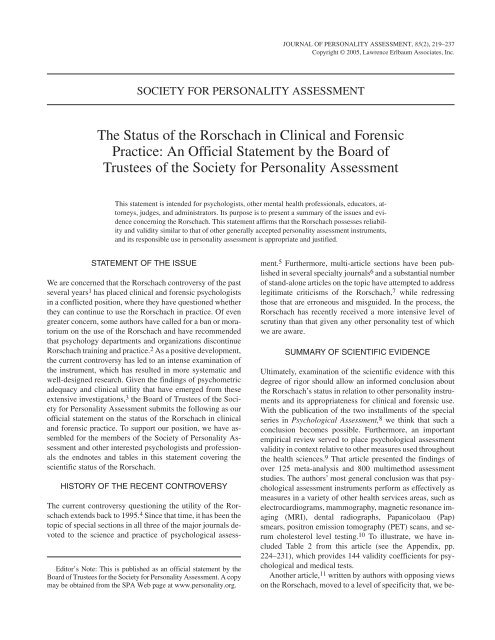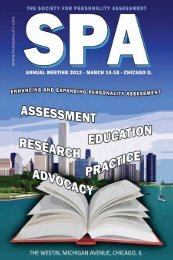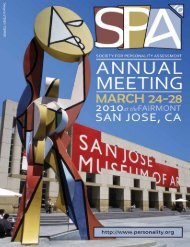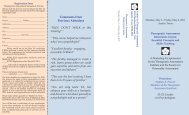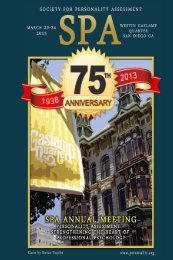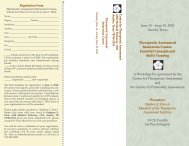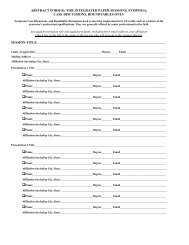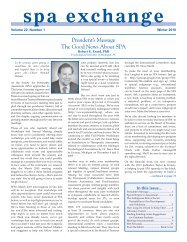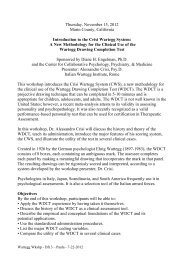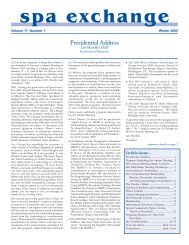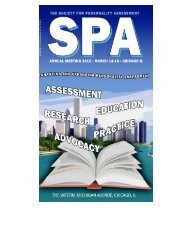The Status of the Rorschach in Clinical and Forensic Practice: An ...
The Status of the Rorschach in Clinical and Forensic Practice: An ...
The Status of the Rorschach in Clinical and Forensic Practice: An ...
Create successful ePaper yourself
Turn your PDF publications into a flip-book with our unique Google optimized e-Paper software.
OFFICIAL STATEMENT BY THE BOARD OF TRUSTEES<br />
JOURNAL OF PERSONALITY ASSESSMENT, 85(2), 219–237<br />
Copyright © 2005, Lawrence Erlbaum Associates, Inc.<br />
SOCIETY FOR PERSONALITY ASSESSMENT<br />
<strong>The</strong> <strong>Status</strong> <strong>of</strong> <strong>the</strong> <strong>Rorschach</strong> <strong>in</strong> Cl<strong>in</strong>ical <strong>and</strong> <strong>Forensic</strong><br />
<strong>Practice</strong>: <strong>An</strong> Official Statement by <strong>the</strong> Board <strong>of</strong><br />
Trustees <strong>of</strong> <strong>the</strong> Society for Personality Assessment<br />
This statement is <strong>in</strong>tended for psychologists, o<strong>the</strong>r mental health pr<strong>of</strong>essionals, educators, attorneys,<br />
judges, <strong>and</strong> adm<strong>in</strong>istrators. Its purpose is to present a summary <strong>of</strong> <strong>the</strong> issues <strong>and</strong> evidence<br />
concern<strong>in</strong>g <strong>the</strong> <strong>Rorschach</strong>. This statement affirms that <strong>the</strong> <strong>Rorschach</strong> possesses reliability<br />
<strong>and</strong> validity similar to that <strong>of</strong> o<strong>the</strong>r generally accepted personality assessment <strong>in</strong>struments,<br />
<strong>and</strong> its responsible use <strong>in</strong> personality assessment is appropriate <strong>and</strong> justified.<br />
STATEMENT OF THE ISSUE<br />
We are concerned that <strong>the</strong> <strong>Rorschach</strong> controversy <strong>of</strong> <strong>the</strong> past<br />
several years 1 has placed cl<strong>in</strong>ical <strong>and</strong> forensic psychologists<br />
<strong>in</strong> a conflicted position, where <strong>the</strong>y have questioned whe<strong>the</strong>r<br />
<strong>the</strong>y can cont<strong>in</strong>ue to use <strong>the</strong> <strong>Rorschach</strong> <strong>in</strong> practice. Of even<br />
greater concern, some authors have called for a ban or moratorium<br />
on <strong>the</strong> use <strong>of</strong> <strong>the</strong> <strong>Rorschach</strong> <strong>and</strong> have recommended<br />
that psychology departments <strong>and</strong> organizations discont<strong>in</strong>ue<br />
<strong>Rorschach</strong> tra<strong>in</strong><strong>in</strong>g <strong>and</strong> practice. 2 As a positive development,<br />
<strong>the</strong> current controversy has led to an <strong>in</strong>tense exam<strong>in</strong>ation <strong>of</strong><br />
<strong>the</strong> <strong>in</strong>strument, which has resulted <strong>in</strong> more systematic <strong>and</strong><br />
well-designed research. Given <strong>the</strong> f<strong>in</strong>d<strong>in</strong>gs <strong>of</strong> psychometric<br />
adequacy <strong>and</strong> cl<strong>in</strong>ical utility that have emerged from <strong>the</strong>se<br />
extensive <strong>in</strong>vestigations, 3 <strong>the</strong> Board <strong>of</strong> Trustees <strong>of</strong> <strong>the</strong> Society<br />
for Personality Assessment submits <strong>the</strong> follow<strong>in</strong>g as our<br />
<strong>of</strong>ficial statement on <strong>the</strong> status <strong>of</strong> <strong>the</strong> <strong>Rorschach</strong> <strong>in</strong> cl<strong>in</strong>ical<br />
<strong>and</strong> forensic practice. To support our position, we have assembled<br />
for <strong>the</strong> members <strong>of</strong> <strong>the</strong> Society <strong>of</strong> Personality Assessment<br />
<strong>and</strong> o<strong>the</strong>r <strong>in</strong>terested psychologists <strong>and</strong> pr<strong>of</strong>essionals<br />
<strong>the</strong> endnotes <strong>and</strong> tables <strong>in</strong> this statement cover<strong>in</strong>g <strong>the</strong><br />
scientific status <strong>of</strong> <strong>the</strong> <strong>Rorschach</strong>.<br />
HISTORY OF THE RECENT CONTROVERSY<br />
Editor’s Note: This is published as an <strong>of</strong>ficial statement by <strong>the</strong><br />
Board <strong>of</strong> Trustees for <strong>the</strong> Society for Personality Assessment. A copy<br />
may be obta<strong>in</strong>ed from <strong>the</strong> SPA Web page at www.personality.org.<br />
<strong>The</strong> current controversy question<strong>in</strong>g <strong>the</strong> utility <strong>of</strong> <strong>the</strong> <strong>Rorschach</strong><br />
extends back to 1995. 4 S<strong>in</strong>ce that time, it has been <strong>the</strong><br />
topic <strong>of</strong> special sections <strong>in</strong> all three <strong>of</strong> <strong>the</strong> major journals devoted<br />
to <strong>the</strong> science <strong>and</strong> practice <strong>of</strong> psychological assessment.<br />
5 Fur<strong>the</strong>rmore, multi-article sections have been published<br />
<strong>in</strong> several specialty journals 6 <strong>and</strong> a substantial number<br />
<strong>of</strong> st<strong>and</strong>-alone articles on <strong>the</strong> topic have attempted to address<br />
legitimate criticisms <strong>of</strong> <strong>the</strong> <strong>Rorschach</strong>, 7 while redress<strong>in</strong>g<br />
those that are erroneous <strong>and</strong> misguided. In <strong>the</strong> process, <strong>the</strong><br />
<strong>Rorschach</strong> has recently received a more <strong>in</strong>tensive level <strong>of</strong><br />
scrut<strong>in</strong>y than that given any o<strong>the</strong>r personality test <strong>of</strong> which<br />
we are aware.<br />
SUMMARY OF SCIENTIFIC EVIDENCE<br />
Ultimately, exam<strong>in</strong>ation <strong>of</strong> <strong>the</strong> scientific evidence with this<br />
degree <strong>of</strong> rigor should allow an <strong>in</strong>formed conclusion about<br />
<strong>the</strong> <strong>Rorschach</strong>’s status <strong>in</strong> relation to o<strong>the</strong>r personality <strong>in</strong>struments<br />
<strong>and</strong> its appropriateness for cl<strong>in</strong>ical <strong>and</strong> forensic use.<br />
With <strong>the</strong> publication <strong>of</strong> <strong>the</strong> two <strong>in</strong>stallments <strong>of</strong> <strong>the</strong> special<br />
series <strong>in</strong> Psychological Assessment, 8 we th<strong>in</strong>k that such a<br />
conclusion becomes possible. Fur<strong>the</strong>rmore, an important<br />
empirical review served to place psychological assessment<br />
validity <strong>in</strong> context relative to o<strong>the</strong>r measures used throughout<br />
<strong>the</strong> health sciences. 9 That article presented <strong>the</strong> f<strong>in</strong>d<strong>in</strong>gs <strong>of</strong><br />
over 125 meta-analysis <strong>and</strong> 800 multimethod assessment<br />
studies. <strong>The</strong> authors’ most general conclusion was that psychological<br />
assessment <strong>in</strong>struments perform as effectively as<br />
measures <strong>in</strong> a variety <strong>of</strong> o<strong>the</strong>r health services areas, such as<br />
electrocardiograms, mammography, magnetic resonance imag<strong>in</strong>g<br />
(MRI), dental radiographs, Papanicolaou (Pap)<br />
smears, positron emission tomography (PET) scans, <strong>and</strong> serum<br />
cholesterol level test<strong>in</strong>g. 10 To illustrate, we have <strong>in</strong>cluded<br />
Table 2 from this article (see <strong>the</strong> Appendix, pp.<br />
224–231), which provides 144 validity coefficients for psychological<br />
<strong>and</strong> medical tests.<br />
<strong>An</strong>o<strong>the</strong>r article, 11 written by authors with oppos<strong>in</strong>g views<br />
on <strong>the</strong> <strong>Rorschach</strong>, moved to a level <strong>of</strong> specificity that, we be-
220 OFFICIAL STATEMENT BY THE BOARD OF TRUSTEES<br />
lieve, allows a clear response to questions about <strong>the</strong> <strong>Rorschach</strong>’s<br />
cl<strong>in</strong>ical <strong>and</strong> forensic utility with<strong>in</strong> <strong>the</strong> overall<br />
context <strong>of</strong> psychological assessment <strong>in</strong>struments. We <strong>in</strong>clude<br />
Tables 2, 3, <strong>and</strong> 4 from this article (see <strong>the</strong> Appendix,<br />
pp. 232–234), which provides extensive meta-analytic data<br />
compar<strong>in</strong>g <strong>the</strong> validity <strong>of</strong> <strong>the</strong> <strong>Rorschach</strong> to <strong>the</strong> validity <strong>of</strong> <strong>in</strong>telligence<br />
scales <strong>and</strong> <strong>the</strong> M<strong>in</strong>nesota Multiphasic Personality<br />
Inventory (MMPI) or its revision (MMPI–2). 12 Summariz<strong>in</strong>g<br />
<strong>the</strong>se f<strong>in</strong>d<strong>in</strong>gs, <strong>the</strong> authors’ conclusion is explicit<br />
about <strong>the</strong> <strong>Rorschach</strong>’s validity:<br />
<strong>the</strong>re is no reason for <strong>the</strong> <strong>Rorschach</strong> to be s<strong>in</strong>gled out for particular<br />
criticism or specific praise. It produces reasonable validity,<br />
roughly on par with o<strong>the</strong>r commonly used tests. 13<br />
This article goes on to state that scientific validity is always<br />
conditional; that is, questions <strong>of</strong> validity for any test<br />
can only be addressed <strong>in</strong> <strong>the</strong> context <strong>of</strong> specific uses. As<br />
such, <strong>the</strong> <strong>Rorschach</strong> is like o<strong>the</strong>r tests for which research supports<br />
<strong>the</strong>ir general validity—all have purposes for which<br />
<strong>the</strong>y are more or less valid. 14 It should be emphasized that<br />
this limitation presents an ongo<strong>in</strong>g challenge for all psychological<br />
<strong>and</strong> medical assessment <strong>in</strong>struments, <strong>and</strong> a ref<strong>in</strong>ed<br />
underst<strong>and</strong><strong>in</strong>g <strong>of</strong> conditional validity is an important direction<br />
for ongo<strong>in</strong>g research.<br />
Overall, meta-analytic reviews <strong>and</strong> <strong>in</strong>dividual studies<br />
show <strong>the</strong> <strong>Rorschach</strong> possesses adequate psychometric properties.<br />
<strong>The</strong> research literature consistently demonstrates that<br />
<strong>the</strong> <strong>Rorschach</strong> can be scored reliably, has scores that measure<br />
important psychological functions, <strong>and</strong> has scores that<br />
provide unique <strong>in</strong>formation that cannot be obta<strong>in</strong>ed from<br />
o<strong>the</strong>r relevant <strong>in</strong>struments or cl<strong>in</strong>ical <strong>in</strong>terviews. <strong>The</strong> extent<br />
to which a test provides unique <strong>in</strong>formation concerns <strong>in</strong>cremental<br />
validity, which is an understudied topic <strong>in</strong> psychological<br />
<strong>and</strong> medical assessment <strong>in</strong> general. 15 However,<br />
<strong>Rorschach</strong> <strong>in</strong>cremental validity has been documented <strong>in</strong> recent<br />
studies 16 <strong>and</strong> <strong>in</strong> a structured review <strong>of</strong> <strong>the</strong> literature. 17<br />
A summary table from this structured review is provided <strong>in</strong><br />
<strong>the</strong> Appendix (on p. 235).<br />
INDEPENDENT BLUE-RIBBON PANEL<br />
EXAMINING MMPI–2 AND RORSCHACH<br />
VALIDITY<br />
One challenge consumers face when evaluat<strong>in</strong>g evidence<br />
concerns <strong>the</strong> potential for researcher biases to <strong>in</strong>fluence <strong>the</strong><br />
evidence that is considered or <strong>the</strong> manner <strong>in</strong> which that evidence<br />
is <strong>in</strong>terpreted. <strong>The</strong> potential for such biases is a particular<br />
concern for traditional narrative literature reviews, <strong>and</strong><br />
systematic meta-analytic summaries are preferred because<br />
<strong>the</strong>y are less subject to <strong>the</strong>se biases. 18 To obta<strong>in</strong> an impartial<br />
summary <strong>of</strong> <strong>the</strong> <strong>Rorschach</strong> validity evidence, a “blue-ribbon<br />
panel” led by Robert Rosenthal, a highly respected statistician,<br />
methodologist, <strong>and</strong> meta-analytic researcher, was commissioned<br />
to review <strong>and</strong> compare <strong>the</strong> validity <strong>of</strong> <strong>the</strong> two most<br />
commonly used cl<strong>in</strong>ical personality assessment measures,<br />
namely <strong>the</strong> <strong>Rorschach</strong> <strong>and</strong> <strong>the</strong> MMPI/MMPI–2. More important,<br />
Rosenthal had not previously conducted research on<br />
<strong>the</strong> <strong>Rorschach</strong> or MMPI/MMPI–2 <strong>and</strong> had no pr<strong>of</strong>essional or<br />
personal <strong>in</strong>vestment <strong>in</strong> <strong>the</strong> outcome <strong>of</strong> <strong>the</strong> review. 19 We <strong>in</strong>clude<br />
Tables 4 <strong>and</strong> 9 from <strong>the</strong> review panel’s <strong>in</strong>itial article 20<br />
on page 236, <strong>and</strong> Table 1 from <strong>the</strong>ir follow-up article 21 on<br />
page 237 <strong>of</strong> <strong>the</strong> Appendix. Both articles reached <strong>the</strong> same<br />
conclusions that <strong>the</strong> MMPI/MMPI–2 <strong>and</strong> <strong>Rorschach</strong> validity<br />
estimates were not reliably different from each o<strong>the</strong>r. 22 <strong>The</strong><br />
panel also found that <strong>the</strong> magnitude <strong>of</strong> <strong>the</strong> <strong>Rorschach</strong> <strong>and</strong><br />
MMPI/MMPI–2 validity was about as good as can be expected<br />
for personality tests. 23<br />
ETHICAL USE AND PROFESSIONAL<br />
PRACTICE<br />
<strong>An</strong> important caveat to our statement regards <strong>the</strong> proper <strong>and</strong><br />
appropriate use <strong>of</strong> <strong>the</strong> <strong>Rorschach</strong> for its <strong>in</strong>tended purposes.<br />
Ethical <strong>and</strong> competent use <strong>of</strong> <strong>the</strong> <strong>Rorschach</strong> requires proper<br />
tra<strong>in</strong><strong>in</strong>g,periodicevaluation<strong>and</strong>cont<strong>in</strong>u<strong>in</strong>geducation,<strong>and</strong>reliance<br />
on established <strong>and</strong> well-researched techniques for adm<strong>in</strong>istration,<br />
cod<strong>in</strong>g, <strong>and</strong> <strong>in</strong>terpretation. As with any test,<br />
those us<strong>in</strong>g <strong>the</strong> <strong>Rorschach</strong> are responsible for its proper application<br />
<strong>and</strong> <strong>in</strong>terpretation. Several specific recommendations<br />
can be made that will enhance ethical <strong>and</strong> pr<strong>of</strong>essional practice.<br />
First, as part <strong>of</strong> st<strong>and</strong>ard cl<strong>in</strong>ical care, <strong>Rorschach</strong>-based<br />
<strong>in</strong>ferences, as with <strong>in</strong>ferences from all psychological tests,<br />
should be <strong>in</strong>tegrated with <strong>in</strong>formation from o<strong>the</strong>r sources,<br />
such as cl<strong>in</strong>ical <strong>in</strong>terview <strong>and</strong> collateral material. Second, cl<strong>in</strong>icians<br />
should recognize factors specific to <strong>Rorschach</strong> test<strong>in</strong>g<br />
that may affect or modify <strong>in</strong>terpretation <strong>of</strong> its scores, such as<br />
how engaged a client was with <strong>the</strong> task. 24 Third, <strong>the</strong> importance<br />
<strong>of</strong> st<strong>and</strong>ardized adm<strong>in</strong>istration <strong>and</strong> scor<strong>in</strong>g cannot be<br />
overstressed. Atypical adm<strong>in</strong>istration <strong>and</strong> scor<strong>in</strong>g can lead to<br />
<strong>in</strong>correct <strong>in</strong>ferences <strong>and</strong> risk mis<strong>in</strong>terpretation <strong>of</strong> <strong>Rorschach</strong><br />
f<strong>in</strong>d<strong>in</strong>gs. Fourth, it is important to attend to <strong>the</strong> research literature<br />
to ensure <strong>Rorschach</strong> <strong>in</strong>ferences are consistent with <strong>the</strong> evidence.<br />
For <strong>in</strong>stance, data have consistently shown a common<br />
depression <strong>in</strong>dex (DEPI) does not identify <strong>in</strong>terview-based diagnoses<br />
<strong>of</strong> major depression, though common psychosis <strong>in</strong>dexes<br />
(SCZI, PTI, TDI) are associated with <strong>in</strong>terview-based<br />
diagnoses <strong>of</strong> psychotic disorders. 25<br />
In addition, although members <strong>of</strong> <strong>the</strong> Board are not aware<br />
<strong>of</strong> psychologists who engage <strong>in</strong> this k<strong>in</strong>d <strong>of</strong> practice, it has<br />
been asserted that some cl<strong>in</strong>icians use <strong>Rorschach</strong> f<strong>in</strong>d<strong>in</strong>gs<br />
alone to draw a legal conclusion or determ<strong>in</strong>e if a historical<br />
event occurred, such as trauma or childhood sexual abuse.<br />
Such a practice is <strong>in</strong>defensible with <strong>the</strong> <strong>Rorschach</strong>, as it is<br />
with any o<strong>the</strong>r personality test.<br />
In conclusion, <strong>the</strong> Board encourages assessment pr<strong>of</strong>essionals<br />
to serve <strong>the</strong>ir clients by avoid<strong>in</strong>g undiscipl<strong>in</strong>ed practice,<br />
as such behavior risks harm<strong>in</strong>g patients <strong>and</strong> o<strong>the</strong>r<br />
clients, discredit<strong>in</strong>g tests, <strong>and</strong> discredit<strong>in</strong>g <strong>the</strong> pr<strong>of</strong>ession<br />
more generally. We encourage psychologists who are aware
OFFICIAL STATEMENT BY THE BOARD OF TRUSTEES 221<br />
<strong>of</strong> practitioners us<strong>in</strong>g <strong>the</strong> <strong>Rorschach</strong> or o<strong>the</strong>r assessment <strong>in</strong>struments<br />
<strong>in</strong> an unethical manner to confront those practitioners<br />
<strong>and</strong> if necessary to take fur<strong>the</strong>r action. 26<br />
RORSCHACH AND LEGAL SETTINGS<br />
We wish to address as well challenges to <strong>the</strong> use <strong>of</strong> <strong>the</strong> <strong>Rorschach</strong><br />
<strong>in</strong> court. 27 Although court <strong>and</strong> legal sett<strong>in</strong>gs require a<br />
higher level <strong>of</strong> expertise <strong>in</strong> <strong>the</strong> use <strong>of</strong> <strong>the</strong> <strong>Rorschach</strong> for expert<br />
testimony, articles summariz<strong>in</strong>g <strong>the</strong> utility <strong>of</strong> <strong>the</strong> <strong>Rorschach</strong><br />
as an <strong>in</strong>strument <strong>in</strong>dicate that <strong>the</strong> <strong>Rorschach</strong> meets<br />
<strong>the</strong> variety <strong>of</strong> legal tests for admissibility, <strong>in</strong>clud<strong>in</strong>g validity,<br />
publication <strong>in</strong> peer reviewed journals, <strong>and</strong> acceptance with<strong>in</strong><br />
<strong>the</strong> relevant pr<strong>of</strong>essional community. 28<br />
CONCLUSIONS<br />
We recognize that differences <strong>of</strong> op<strong>in</strong>ion are crucial to <strong>the</strong><br />
scientific enterprise <strong>and</strong> we welcome rigorous <strong>in</strong>vestigations<br />
<strong>of</strong> specific claims for <strong>the</strong> validity <strong>of</strong> specific <strong>Rorschach</strong> <strong>in</strong>dexes,<br />
as we do with all personality assessment techniques.<br />
We also recognize that <strong>the</strong> use <strong>of</strong> particular <strong>in</strong>struments <strong>in</strong><br />
practice is, <strong>in</strong> part, a matter <strong>of</strong> personal preference. However,<br />
we disagree with <strong>the</strong> wholesale rejection or discount<strong>in</strong>g <strong>of</strong><br />
any particular technique where <strong>the</strong> scientific data do not warrant<br />
it. <strong>The</strong>refore, it is <strong>the</strong> position <strong>of</strong> <strong>the</strong> Board <strong>of</strong> Trustees <strong>of</strong><br />
<strong>the</strong> Society for Personality Assessment that <strong>the</strong> <strong>Rorschach</strong><br />
possesses documented reliability <strong>and</strong> validity similar to o<strong>the</strong>r<br />
generally accepted test <strong>in</strong>struments used <strong>in</strong> <strong>the</strong> assessment <strong>of</strong><br />
personality <strong>and</strong> psychopathology <strong>and</strong> that its responsible use<br />
<strong>in</strong> personality assessment is appropriate <strong>and</strong> justified.<br />
ENDNOTES<br />
1 For example, for criticisms <strong>of</strong> <strong>the</strong> <strong>Rorschach</strong>, see Garb, Wood,<br />
Nezworski, Grove, <strong>and</strong> Stejskal (2001), Lilienfeld, Wood, <strong>and</strong> Garb<br />
(2000), Wood, Lilienfeld, Garb, <strong>and</strong> Nezworski (2000b), Wood,<br />
Nezworski, Garb, <strong>and</strong> Lilienfeld (2001a), Wood, Nezworski,<br />
Lilienfeld, <strong>and</strong> Garb (2003), <strong>and</strong> Wood, Nezworski, <strong>and</strong> Stejskal<br />
(1996a, 1996b); for reviews <strong>of</strong> evidence support<strong>in</strong>g reliability <strong>and</strong><br />
validity, see Meyer (2004), Meyer <strong>and</strong> Archer (2001), Meyer et al.<br />
(2002), Viglione (1999), <strong>and</strong> Viglione <strong>and</strong> Hilsenroth (2001). For a<br />
broader perspective, see Bornste<strong>in</strong> <strong>and</strong> Masl<strong>in</strong>g (2005) <strong>and</strong> Exner<br />
(2003) who provide historical reviews <strong>of</strong> <strong>the</strong> various controversies<br />
that have arisen about <strong>the</strong> <strong>Rorschach</strong> s<strong>in</strong>ce its orig<strong>in</strong>al publication <strong>in</strong><br />
1921 (<strong>Rorschach</strong>, 1921).<br />
2 For a review <strong>of</strong> <strong>the</strong>se arguments, see Garb (1999), Grove <strong>and</strong><br />
Barden (1999), Grove, Barden, Garb, <strong>and</strong> Lilienfeld (2002),<br />
Lilienfeld et al. (2000), <strong>and</strong> Wood et al. (2003); although for rejo<strong>in</strong>ders,<br />
see Hibbard (2003) <strong>and</strong> Ritzler, Erard, <strong>and</strong> Pettigrew (2002a,<br />
2002b).<br />
3 For recent meta-analytic reviews <strong>of</strong> <strong>Rorschach</strong> validity or <strong>in</strong>cremental<br />
validity, see Bornste<strong>in</strong> (1999), Grønnerød (2004), Hiller,<br />
Rosenthal, Bornste<strong>in</strong>, Berry, <strong>and</strong> Brunell-Neulieb (1999),<br />
Jørgensen, <strong>An</strong>dersen, <strong>and</strong> Dam (2000, 2001), Meyer (2000), Meyer<br />
<strong>and</strong> Archer (2001), Meyer <strong>and</strong> H<strong>and</strong>ler (1997, 2000), Rosenthal,<br />
Hiller, Bornste<strong>in</strong>, Berry, <strong>and</strong> Brunell-Neulieb (2001); for meta-analytic<br />
reviews <strong>of</strong> <strong>in</strong>terrater reliability, see Meyer (2004) <strong>and</strong> Meyer et<br />
al. (2002); for meta-analytic reviews <strong>of</strong> test–retest reliability or <strong>the</strong><br />
stability <strong>of</strong> scores over time, see Grønnerød (2003) <strong>and</strong> Roberts <strong>and</strong><br />
DelVecchio (2001). For a review <strong>of</strong> research document<strong>in</strong>g <strong>in</strong>cremental<br />
validity, see Viglione <strong>and</strong> Hilsenroth (2001); <strong>and</strong> for a contemporary<br />
study exam<strong>in</strong><strong>in</strong>g <strong>the</strong> reliability <strong>of</strong> cl<strong>in</strong>icians <strong>in</strong>terpret<strong>in</strong>g<br />
<strong>the</strong> <strong>Rorschach</strong>, see Meyer, Mihura, <strong>and</strong> Smith (2005).<br />
4 See Exner (1995, 1996), Nezworski <strong>and</strong> Wood (1995), <strong>and</strong><br />
Wood et al. (1996a, 1996b).<br />
5 For example, Psychological Assessment (Meyer, 1999, 2001);<br />
Assessment (Archer, 1999; Wood, Nezworski, Stejskal, Garven, &<br />
West, 1999); Journal <strong>of</strong> Personality Assessment (K<strong>in</strong>der, 2001).<br />
6 See Cl<strong>in</strong>ical Psychology: Science <strong>and</strong> <strong>Practice</strong> (Aronow, 2001;<br />
Exner, 2001; Hunsley & DiGuilio, 2001; Meyer, 2001; Widiger,<br />
2001; Wood, Nezworski, Garb, et al., 2001a, 2001b); Journal <strong>of</strong><br />
Cl<strong>in</strong>ical Psychology (Garfield, 2000a, 2000b; Lerner, 2000; We<strong>in</strong>er,<br />
2000; Wood et al., 2000a, 2000b); Journal <strong>of</strong> <strong>Forensic</strong> Psychology<br />
<strong>Practice</strong> (Gacono, 2002; Hamel, Gallager, & Soares, 2001; Wood,<br />
Nezworski, Stejskal, & McK<strong>in</strong>zey, 2001), <strong>and</strong> Psychology, Public<br />
Policy, <strong>and</strong> Law (Grove et al., 2002; Ritzler et al., 2002a; 2002b).<br />
7 For overviews, see Meyer <strong>and</strong> Archer (2001) <strong>and</strong> We<strong>in</strong>er (2001).<br />
8 Meyer (Ed.; 1999, 2001).<br />
9<br />
Meyer et al. (2001).<br />
10 “Validity coefficients for many psychological tests are <strong>in</strong>dist<strong>in</strong>guishable<br />
from those observed for many medical tests. For <strong>in</strong>stance,<br />
when consider<strong>in</strong>g validity coefficients <strong>in</strong> <strong>the</strong> .30–.50 range, one<br />
f<strong>in</strong>ds results from <strong>the</strong> MMPI, Millon Cl<strong>in</strong>ical Multiaxial Inventory,<br />
<strong>The</strong>matic Apperception Test, <strong>Rorschach</strong>, Hare Psychopathy Checklist,<br />
various neuropsychological <strong>and</strong> cognitive tests, <strong>and</strong> <strong>the</strong> impact<br />
<strong>of</strong> psychological assessment feedback on <strong>the</strong> subsequent well-be<strong>in</strong>g<br />
<strong>of</strong> patients. One also f<strong>in</strong>ds results from electrocardiograms, mammography,<br />
magnetic resonance imag<strong>in</strong>g (MRI), dental radiographs,<br />
Papanicolaou (Pap) smears, cardiac fluoroscopy, s<strong>in</strong>gle photon<br />
emission computed tomography, technetium bone scann<strong>in</strong>g, <strong>and</strong> serum<br />
cholesterol level.” (Meyer et al., 2001, p. 135).<br />
11 Meyer <strong>and</strong> Archer (2001).<br />
12 MMPI: Hathaway <strong>and</strong> McK<strong>in</strong>ley (1943); MMPI–2: Butcher,<br />
Dahlstrom, Graham, Tellegen, <strong>and</strong> Kaemmer (1989).<br />
13<br />
Meyer <strong>and</strong> Archer (2001, pp. 491–492).<br />
14 We<strong>in</strong>er (1996).<br />
15 See Hunsley (2003) <strong>and</strong> Hunsley <strong>and</strong> Meyer (2003).<br />
16<br />
See Fowler, Piers, Hilsenroth, Holdwick, <strong>and</strong> Padawer (2001),<br />
Hartmann, Sunde, Kristensen, <strong>and</strong> Mart<strong>in</strong>ussen (2003), Hartmann,<br />
Wang, Berg, <strong>and</strong> Sæ<strong>the</strong>r (2003), Janson <strong>and</strong> Statt<strong>in</strong> (2003), Meyer<br />
(2000), Stokes, Pogge, Powell-Lunder, Ward, Bilg<strong>in</strong>er, <strong>and</strong> DeLuca<br />
(2003), <strong>and</strong> Sultan, Jebrane, <strong>and</strong> Heurtier-Hartemann (2002).<br />
17<br />
See Viglione <strong>and</strong> Hilsenroth (2001), which summarizes f<strong>in</strong>d<strong>in</strong>gs<br />
described <strong>in</strong> Viglione (1999).<br />
18 See Hunter <strong>and</strong> Schmidt (2004) or Lipsey <strong>and</strong> Wilson (2001).<br />
19 At <strong>the</strong> same time, to ensure each test was adequately represented,<br />
<strong>the</strong> panel <strong>in</strong>cluded researchers with recognized meta-analytic<br />
expertise applied to <strong>the</strong> <strong>Rorschach</strong> (Robert F. Bornste<strong>in</strong>) <strong>and</strong><br />
<strong>the</strong> MMPI/MMPI–2 (David T. R. Berry).<br />
20 Hiller et al. (1999).<br />
21 Rosenthal et al. (2001).<br />
22 “In a meta-analytic comparison <strong>of</strong> criterion-related validity coefficients<br />
for <strong>the</strong> MMPI <strong>and</strong> for <strong>the</strong> <strong>Rorschach</strong>, we found both <strong>in</strong>struments<br />
to have validity effect sizes <strong>of</strong> substantial magnitude (unweighted<br />
mean r <strong>of</strong> .30 <strong>and</strong> .29 for <strong>the</strong> MMPI <strong>and</strong> <strong>Rorschach</strong>,<br />
respectively). Validity estimates for <strong>the</strong> MMPI <strong>and</strong> <strong>Rorschach</strong> were<br />
not reliably different from each o<strong>the</strong>r, even when studies <strong>in</strong> which<br />
test predictors <strong>and</strong> criterion variables had common measurement<br />
methods were removed from consideration. … <strong>The</strong> methodological<br />
features <strong>of</strong> this study, <strong>in</strong>clud<strong>in</strong>g r<strong>and</strong>om sampl<strong>in</strong>g from <strong>the</strong> published<br />
literature, expert judgments for <strong>in</strong>clusion <strong>of</strong> validity evidence,<br />
<strong>and</strong> <strong>the</strong> use <strong>of</strong> accepted effect size estimation techniques, lend
222 OFFICIAL STATEMENT BY THE BOARD OF TRUSTEES<br />
greater credibility to <strong>the</strong>se results compared with those from previous<br />
efforts.” (Hiller et al. 1999, pp. 291–292).<br />
23 “As noted by Cohen (1988), ‘when one looks at <strong>the</strong> near-maximum<br />
correlation coefficients <strong>of</strong> personality measures with … reallife<br />
criteria, <strong>the</strong> values one encounters fall at <strong>the</strong> order <strong>of</strong> … r = .30’<br />
(p. 81). In o<strong>the</strong>r words, validity for <strong>the</strong>se <strong>in</strong>struments is about as<br />
good as can be expected for personality tests.” (Hiller et al., 1999. p.<br />
291).<br />
24 See Meyer (1993, 1997).<br />
25 See Jørgensen et al. (2000, 2001). DEPI = Depression Index,<br />
SCZI = Schizophrenia Index, PTI = Perceptual-Th<strong>in</strong>k<strong>in</strong>g Index, TDI<br />
= Thought Disorder Index.<br />
26 <strong>The</strong> Code <strong>of</strong> Ethics <strong>of</strong> <strong>the</strong> American Psychological Association<br />
(APA, 2002) can serve as a guidel<strong>in</strong>e for fur<strong>the</strong>r action, <strong>in</strong>clud<strong>in</strong>g, when<br />
appropriate, fil<strong>in</strong>g an ethical compla<strong>in</strong>t with <strong>the</strong> APA, relevant state association,<br />
Board <strong>of</strong> Exam<strong>in</strong>ers, or o<strong>the</strong>r pr<strong>of</strong>essional association.<br />
27 Grove <strong>and</strong> Barden (1999); Grove et al. (2002), <strong>and</strong> Wood,<br />
Nezworski, Stejskal et al. (2001).<br />
28 Gacono, Evans, <strong>and</strong> Viglione (2002); Hilsenroth <strong>and</strong> Stricker<br />
(2004) McCann (1998); Ritzler et al. (2002a, 2002b).<br />
REFERENCES<br />
American Psychological Association. (2002). Ethical pr<strong>in</strong>ciples <strong>of</strong> psychologists<br />
<strong>and</strong> code <strong>of</strong> conduct. American Psychologist, 57, 1060–1073.<br />
Archer, R. P. (Ed.). (1999). Perspectives on <strong>the</strong> <strong>Rorschach</strong> [Special section].<br />
Assessment, 6, 307–351.<br />
Aronow, E. (2001). CS norms, psychometrics, <strong>and</strong> possibilities for <strong>the</strong> <strong>Rorschach</strong><br />
technique. Cl<strong>in</strong>ical Psychology: Science & <strong>Practice</strong>, 8, 383–385.<br />
Bornste<strong>in</strong>, R. F. (1999). Criterion validity <strong>of</strong> objective <strong>and</strong> projective dependency<br />
tests: A meta-analytic assessment <strong>of</strong> behavioral prediction. Psychological<br />
Assessment, 11, 48–57.<br />
Bornste<strong>in</strong>, R. F., & Masl<strong>in</strong>g, J. M. (2005). Scor<strong>in</strong>g <strong>the</strong> <strong>Rorschach</strong>: Seven validated<br />
systems. Mahwah, NJ: Lawrence Erlbaum Associates, Inc.<br />
Butcher, J. N., Dahlstrom, W. G., Graham, J. R., Tellegen, A., & Kaemmer,<br />
B. (1989). MMPI–2: M<strong>in</strong>nesota Multiphasic Personality Inventory—2:<br />
Manual for adm<strong>in</strong>istration <strong>and</strong> scor<strong>in</strong>g. M<strong>in</strong>neapolis: University <strong>of</strong> M<strong>in</strong>nesota<br />
Press.<br />
Cohen, J. (1988). Statistical power analyses for <strong>the</strong> behavioral sciences (2nd<br />
ed.). Hillsdale, NJ: Lawrence Erlbaum Associates, Inc.<br />
Exner, J. E. (1995). “Narcissism <strong>in</strong> <strong>the</strong> Comprehensive System for <strong>the</strong> <strong>Rorschach</strong>”:<br />
Comment. Cl<strong>in</strong>ical Psychology: Science & <strong>Practice</strong>, 2,<br />
200–206.<br />
Exner, J. E. (1996). A comment on “<strong>The</strong> Comprehensive System for <strong>the</strong> <strong>Rorschach</strong>:<br />
A critical exam<strong>in</strong>ation.” Psychological Science, 7, 11–13.<br />
Exner, J. E. (2001). A comment on “<strong>The</strong> misperception <strong>of</strong> psychopathology:<br />
Problems with norms <strong>of</strong> <strong>the</strong> Comprehensive System for <strong>the</strong> <strong>Rorschach</strong>.”<br />
Cl<strong>in</strong>ical Psychology: Science & <strong>Practice</strong>, 8, 386–396.<br />
Exner, J. E. (2003). <strong>The</strong> <strong>Rorschach</strong>: A Comprehensive System (4th ed.). New<br />
York: Wiley.<br />
Fowler, J. C., Piers, C., Hilsenroth, M. J., Holdwick, D. J., & Padawer, J. R.<br />
(2001). <strong>The</strong> <strong>Rorschach</strong> suicide constellation: Assess<strong>in</strong>g various degrees<br />
<strong>of</strong> lethality. Journal <strong>of</strong> Personality Assessment, 76, 333–351.<br />
Gacono, C. B. (Ed.). (2002). <strong>Forensic</strong> psychodiagnostic test<strong>in</strong>g [Special section].<br />
Journal <strong>of</strong> <strong>Forensic</strong> Psychology <strong>Practice</strong>, 2, 1–117.<br />
Gacono, C. B., Evans, F. B., & Viglione, D. J. (2002). <strong>The</strong> <strong>Rorschach</strong> <strong>in</strong> forensic<br />
practice. Journal <strong>of</strong> <strong>Forensic</strong> Psychology <strong>Practice</strong>, 2, 33–54.<br />
Garb, H. N. (1999). Call for a moratorium on <strong>the</strong> use <strong>of</strong> <strong>the</strong> <strong>Rorschach</strong> Inkblot<br />
Test <strong>in</strong> cl<strong>in</strong>ical <strong>and</strong> forensic sett<strong>in</strong>gs. Assessment, 6, 313–317.<br />
Garb, H. N., Wood, J. M., Nezworski, M. T., Grove, W. M., & Stejskal, W. J.<br />
(2001). Toward a resolution <strong>of</strong> <strong>the</strong> <strong>Rorschach</strong> controversy. Psychological<br />
Assessment, 13, 433–448.<br />
Garfield, S. L. (2000a). <strong>The</strong> <strong>Rorschach</strong> test <strong>in</strong> cl<strong>in</strong>ical diagnosis. Journal <strong>of</strong><br />
Cl<strong>in</strong>ical Psychology, 56, 387–393.<br />
Garfield, S. L. (2000b). “<strong>The</strong> <strong>Rorschach</strong> test <strong>in</strong> cl<strong>in</strong>ical diagnosis”: A brief<br />
commentary. Journal <strong>of</strong> Cl<strong>in</strong>ical Psychology, 56, 431–434.<br />
Grønnerød, C. (2003). Temporal stability <strong>in</strong> <strong>the</strong> <strong>Rorschach</strong> method: A metaanalytic<br />
review. Journal <strong>of</strong> Personality Assessment, 80, 272–293.<br />
Grønnerød, C. (2004). <strong>Rorschach</strong> assessment <strong>of</strong> changes follow<strong>in</strong>g psycho<strong>the</strong>rapy:<br />
A meta-analytic review. Journal <strong>of</strong> Personality Assessment, 83,<br />
256–276.<br />
Grove, W. M., & Barden, R. C. (1999). Protect<strong>in</strong>g <strong>the</strong> <strong>in</strong>tegrity <strong>of</strong> <strong>the</strong> legal<br />
system: <strong>The</strong> admissibility <strong>of</strong> testimony from mental health experts under<br />
Daubert/Kumho analyses. Psychology, Public Policy, & Law, 5, 224–242.<br />
Grove, W. M., Barden, R. C., Garb, H. N., & Lilienfeld, S. O. (2002). Failure<br />
<strong>of</strong> <strong>Rorschach</strong>-Comprehensive-System-based testimony to be admissible<br />
under <strong>the</strong> Daubert-Jo<strong>in</strong>er-Kumho st<strong>and</strong>ard. Psychology, Public Policy, &<br />
Law, 8, 216–234.<br />
Hamel, M., Gallagher, S., & Soares, C. (2001). <strong>The</strong> <strong>Rorschach</strong>: Here we go<br />
aga<strong>in</strong>. Journal <strong>of</strong> <strong>Forensic</strong> Psychology <strong>Practice</strong>, 1, 79–88.<br />
Hartmann, E., Sunde, T., Kristensen, W., & Mart<strong>in</strong>ussen, M. (2003a). Psychological<br />
measures as predictors <strong>of</strong> military tra<strong>in</strong><strong>in</strong>g performance. Journal<br />
<strong>of</strong> Personality Assessment, 80, 87–98.<br />
Hartmann, E., Wang, C. E., Berg, M., & Sae<strong>the</strong>r, L. (2003b). Depression <strong>and</strong><br />
vulnerability as assessed by <strong>the</strong> <strong>Rorschach</strong> method. Journal <strong>of</strong> Personality<br />
Assessment, 81, 242–255.<br />
Hathaway, S. R., & McK<strong>in</strong>ley, J. C. (1943). <strong>The</strong> M<strong>in</strong>nesota Multiphasic Personality<br />
Inventory. M<strong>in</strong>neapolis: University <strong>of</strong> M<strong>in</strong>nesota Press.<br />
Hibbard, S. (2003). A critique <strong>of</strong> Lilienfeld et al.’s (2000) “<strong>The</strong> scientific status<br />
<strong>of</strong> projective techniques”. Journal <strong>of</strong> Personality Assessment, 80,<br />
260–271.<br />
Hiller, J. B., Rosenthal, R., Bornste<strong>in</strong>, R. F., Berry, D. T. R., & Brunell-<br />
Neuleib, S. (1999). A comparative meta-analysis <strong>of</strong> <strong>Rorschach</strong> <strong>and</strong><br />
MMPI validity. Psychological Assessment, 11, 278–296.<br />
Hilsenroth, M. J., & Stricker, G. (2004). A consideration <strong>of</strong> challenges to<br />
psychological assessment <strong>in</strong>struments used <strong>in</strong> forensic sett<strong>in</strong>gs: <strong>Rorschach</strong><br />
as exemplar. Journal <strong>of</strong> Personality Assessment, 83, 141–152.<br />
Hunsley, J. (2003). Introduction to <strong>the</strong> special section on <strong>in</strong>cremental validity<br />
<strong>and</strong> utility <strong>in</strong> cl<strong>in</strong>ical assessment. Psychological Assessment, 15, 443–445.<br />
Hunsley, J., & Di Giulio, G. (2001). Norms, norm<strong>in</strong>g, <strong>and</strong> cl<strong>in</strong>ical assessment.<br />
Cl<strong>in</strong>ical Psychology: Science & <strong>Practice</strong>, 8, 378–382.<br />
Hunsley, J., & Meyer, G. J. (2003). <strong>The</strong> <strong>in</strong>cremental validity <strong>of</strong> psychological<br />
test<strong>in</strong>g <strong>and</strong> assessment: conceptual, methodological, <strong>and</strong> statistical issues.<br />
Psychological Assessment, 15, 446–455.<br />
Hunter, J. E., & Schmidt, F. L. (2004). Methods <strong>of</strong> meta-analyses: Correct<strong>in</strong>g<br />
error <strong>and</strong> bias <strong>in</strong> research f<strong>in</strong>d<strong>in</strong>gs (2nd ed.). Thous<strong>and</strong> Oaks, CA: Sage.<br />
Janson, H., & Statt<strong>in</strong>, H. (2003). Prediction <strong>of</strong> adolescent <strong>and</strong> adult from childhood<br />
<strong>Rorschach</strong> rat<strong>in</strong>gs. Journal <strong>of</strong> Personality Assessment, 81, 51–63.<br />
Jorgensen, K., <strong>An</strong>dersen, T. J., & Dam, H. (2000). <strong>The</strong> diagnostic efficiency<br />
<strong>of</strong> <strong>the</strong> <strong>Rorschach</strong> Depression Index <strong>and</strong> <strong>the</strong> Schizophrenia Index: A review.<br />
Assessment, 7, 259–280.<br />
Jorgensen, K., <strong>An</strong>dersen, T. J., & Dam, H. (2001). “<strong>The</strong> diagnostic efficiency<br />
<strong>of</strong> <strong>the</strong> <strong>Rorschach</strong> Depression Index <strong>and</strong> <strong>the</strong> Schizophrenia Index:<br />
A review”: Erratum. Assessment, 8, 355.<br />
K<strong>in</strong>der, B. N. (Ed.). (2001). More data on <strong>the</strong> current <strong>Rorschach</strong> controversy<br />
[Special series]. Journal <strong>of</strong> Personality Assessment, 77, 1–70.<br />
Lerner, P. M. (2000). A nonreviewer’s comment: On <strong>the</strong> <strong>Rorschach</strong> <strong>and</strong><br />
baseball. Journal <strong>of</strong> Cl<strong>in</strong>ical Psychology, 56, 439.<br />
Lilienfeld, S. O., Wood, J. M., & Garb, H. N. (2000). <strong>The</strong> scientific status <strong>of</strong><br />
projective techniques. Psychological Science <strong>in</strong> <strong>the</strong> Public Interest, 1,<br />
27–66.<br />
Lipsey, M. W., & Wilson, D. B. (2001). Practical meta-analysis. Thous<strong>and</strong><br />
Oaks, CA: Sage.<br />
McCann, J. T. (1998). Defend<strong>in</strong>g <strong>the</strong> <strong>Rorschach</strong> <strong>in</strong> court: <strong>An</strong> analysis <strong>of</strong> admissibility<br />
us<strong>in</strong>g legal <strong>and</strong> pr<strong>of</strong>essional st<strong>and</strong>ards. Journal <strong>of</strong> Personality<br />
Assessment, 70, 125–144.<br />
Meyer, G. J. (1993). <strong>The</strong> impact <strong>of</strong> response frequency on <strong>the</strong> <strong>Rorschach</strong><br />
constellation <strong>in</strong>dices <strong>and</strong> on <strong>the</strong>ir validity with diagnostic <strong>and</strong> MMPI–2<br />
criteria. Journal <strong>of</strong> Personality Assessment, 60, 153–180.
OFFICIAL STATEMENT BY THE BOARD OF TRUSTEES 223<br />
Meyer, G. J. (1997). On <strong>the</strong> <strong>in</strong>tegration <strong>of</strong> personality assessment methods:<br />
<strong>The</strong> <strong>Rorschach</strong> <strong>and</strong> MMPI. Journal <strong>of</strong> Personality Assessment, 68,<br />
297–330.<br />
Meyer, G. J. (Ed.). (1999). Special section 1: <strong>The</strong> utility <strong>of</strong> <strong>the</strong> <strong>Rorschach</strong> for<br />
cl<strong>in</strong>ical assessment [Special section]. Psychological Assessment, 11,<br />
235–302.<br />
Meyer, G. J. (2000). <strong>The</strong> <strong>in</strong>cremental validity <strong>of</strong> <strong>the</strong> <strong>Rorschach</strong> Prognostic<br />
Rat<strong>in</strong>g Scale over <strong>the</strong> MMPI Ego Strength Scale <strong>and</strong> IQ. Journal <strong>of</strong> Personality<br />
Assessment, 74, 356–370.<br />
Meyer, G. J. (2001). Evidence to correct misperceptions about <strong>Rorschach</strong><br />
norms. Cl<strong>in</strong>ical Psychology: Science & <strong>Practice</strong>, 8, 389–396.<br />
Meyer, G. J. (Ed.). (2001). Special section 2: <strong>The</strong> utility <strong>of</strong> <strong>the</strong> <strong>Rorschach</strong> for<br />
cl<strong>in</strong>ical assessment [Special section]. Psychological Assessment, 13,<br />
419–502.<br />
Meyer, G. J. (2004). <strong>The</strong> reliability <strong>and</strong> validity <strong>of</strong> <strong>the</strong> <strong>Rorschach</strong> <strong>and</strong> TAT<br />
compared to o<strong>the</strong>r psychological <strong>and</strong> medical procedures: <strong>An</strong> analysis <strong>of</strong><br />
systematically ga<strong>the</strong>red evidence. In M. J. Hilsenroth & D. Segal (Vol.<br />
Eds.) & M. Hersen (Series Ed.), Personality assessment. Vol. 2. Comprehensive<br />
h<strong>and</strong>book <strong>of</strong> psychological assessment (pp. 315–342). Hoboken,<br />
NJ: Wiley.<br />
Meyer, G. J., & Archer, R. P. (2001). <strong>The</strong> hard science <strong>of</strong> <strong>Rorschach</strong> research:<br />
What do we know <strong>and</strong> where do we go Psychological Assessment,<br />
13, 486–502.<br />
Meyer, G. J., F<strong>in</strong>n, S. E., Eyde, L. D., Kay, G. G., Morel<strong>and</strong>, K. L., Dies, R.<br />
R., et al. (2001). Psychological test<strong>in</strong>g <strong>and</strong> psychological assessment: A<br />
review <strong>of</strong> evidence <strong>and</strong> issues. American Psychologist, 56, 128–165.<br />
Meyer, G. J., & H<strong>and</strong>ler, L. (1997). <strong>The</strong> ability <strong>of</strong> <strong>the</strong> <strong>Rorschach</strong> to predict<br />
subsequent outcome: A meta-analysis <strong>of</strong> <strong>the</strong> <strong>Rorschach</strong> Prognostic Rat<strong>in</strong>g<br />
Scale. Journal <strong>of</strong> Personality Assessment, 69, 1–38.<br />
Meyer, G. J., & H<strong>and</strong>ler, L. (2000). “<strong>The</strong> ability <strong>of</strong> <strong>the</strong> <strong>Rorschach</strong> to predict<br />
subsequent outcome: A meta-analysis <strong>of</strong> <strong>the</strong> <strong>Rorschach</strong> Prognostic<br />
Rat<strong>in</strong>g Scale”: Correction. Journal <strong>of</strong> Personality Assessment, 74,<br />
504–506.<br />
Meyer, G. J., Hilsenroth, M. J., Baxter, D., Exner, J. E., Fowler, J. C., Piers,<br />
C. C., et al. (2002). <strong>An</strong> exam<strong>in</strong>ation <strong>of</strong> <strong>in</strong>terrater reliability for scor<strong>in</strong>g <strong>the</strong><br />
<strong>Rorschach</strong> comprehensive system <strong>in</strong> eight data sets. Journal <strong>of</strong> Personality<br />
Assessment, 78, 219–274.<br />
Meyer, G. J., Mihura, J. L., & Smith, B. L. (2005). <strong>The</strong> <strong>in</strong>tercl<strong>in</strong>ician reliability<br />
<strong>of</strong> <strong>Rorschach</strong> <strong>in</strong>terpretation <strong>in</strong> four data sets. Journal <strong>of</strong> Personality<br />
Assessment, 84, 296–314.<br />
Nezworski, M. T., & Wood, J. M. (1995). Narcissism <strong>in</strong> <strong>the</strong> Comprehensive<br />
System for <strong>the</strong> <strong>Rorschach</strong>. Cl<strong>in</strong>ical Psychology: Science & <strong>Practice</strong>, 2,<br />
179–199.<br />
Ritzler, B., Erard, R., & Pettigrew, G. (2002a). A f<strong>in</strong>al reply to Grove <strong>and</strong><br />
Barden: <strong>The</strong> relevance <strong>of</strong> <strong>the</strong> <strong>Rorschach</strong> Comprehensive System for expert<br />
testimony. Psychology, Public Policy, & Law, 8, 235–246.<br />
Ritzler, B., Erard, R., & Pettigrew, G. (2002b). Protect<strong>in</strong>g <strong>the</strong> <strong>in</strong>tegrity <strong>of</strong><br />
<strong>Rorschach</strong> expert witnesses: A reply to Grove <strong>and</strong> Barden (1999) re: <strong>The</strong><br />
admissibility <strong>of</strong> testimony under Daubert/Kumho analyses. Psychology,<br />
Public Policy, & Law, 8, 201–215.<br />
Roberts, B. W., & DelVecchio, W. F. (2000). <strong>The</strong> rank-order consistency <strong>of</strong><br />
personality traits from childhood to old age: A quantitative review <strong>of</strong> longitud<strong>in</strong>al<br />
studies. Psychological Bullet<strong>in</strong>, 126, 3–25.<br />
<strong>Rorschach</strong>, H. (1921). Psychodiagnostik. Bern, Switzerl<strong>and</strong>: Bircher.<br />
Rosenthal, R., Hiller, J. B., Bornste<strong>in</strong>, R. F., Berry, D. T. R., & Brunell-<br />
Neuleib, S. (2001). Meta-analytic methods, <strong>the</strong> <strong>Rorschach</strong>, <strong>and</strong> <strong>the</strong><br />
MMPI. Psychological Assessment, 13, 449–451.<br />
Stokes, J. M., Pogge, D. L., Powell-Lunder, J., Ward, A. W., Bilg<strong>in</strong>er, L., &<br />
DeLuca, V. A. (2003). <strong>The</strong> <strong>Rorschach</strong> Ego Impairment Index: Prediction<br />
<strong>of</strong> treatment outcome <strong>in</strong> a child psychiatric population. Journal <strong>of</strong> Personality<br />
Assessment, 81, 11–19.<br />
Sultan, S., Jebrane, A., & Heurtier-Hartemann, A. (2002). <strong>Rorschach</strong> variables<br />
related to blood glucose control <strong>in</strong> <strong>in</strong>sul<strong>in</strong>-dependent diabetes patients.<br />
Journal <strong>of</strong> Personality Assessment, 79, 122–141.<br />
Viglione, D. J. (1999). A review <strong>of</strong> recent research address<strong>in</strong>g <strong>the</strong> utility <strong>of</strong><br />
<strong>the</strong> <strong>Rorschach</strong>. Psychological Assessment, 11, 251–265.<br />
Viglione, D. J., & Hilsenroth, M. J. (2001). <strong>The</strong> <strong>Rorschach</strong>: Facts, fictions,<br />
<strong>and</strong> future. Psychological Assessment, 13, 452–471.<br />
We<strong>in</strong>er, I. B. (1996). Some observations on <strong>the</strong> validity <strong>of</strong> <strong>the</strong> <strong>Rorschach</strong><br />
Inkblot Method. Psychological Assessment, 8, 206–213.<br />
We<strong>in</strong>er, I. B. (2000). Us<strong>in</strong>g <strong>the</strong> <strong>Rorschach</strong> properly <strong>in</strong> practice <strong>and</strong> research.<br />
Journal <strong>of</strong> Cl<strong>in</strong>ical Psychology, 56, 435–438.<br />
We<strong>in</strong>er, I. B. (2001). Advanc<strong>in</strong>g <strong>the</strong> science <strong>of</strong> psychological assessment:<br />
<strong>The</strong> <strong>Rorschach</strong> Inkblot Method as exemplar. Psychological Assessment,<br />
13, 423–432.<br />
Widiger, T. A. (2001). <strong>The</strong> best <strong>and</strong> <strong>the</strong> worst <strong>of</strong> us Cl<strong>in</strong>ical Psychology:<br />
Science & <strong>Practice</strong>, 8, 374–377.<br />
Wood, J. M., Lilienfeld, S. O., Garb, H. N., & Nezworski, M. T. (2000a).<br />
Limitations <strong>of</strong> <strong>the</strong> <strong>Rorschach</strong> as a diagnostic tool: A reply to Garfield<br />
(2000), Lerner (2000), <strong>and</strong> We<strong>in</strong>er (2000). Journal <strong>of</strong> Cl<strong>in</strong>ical Psychology,<br />
56, 441–448.<br />
Wood, J. M., Lilienfeld, S. O., Garb, H. N., & Nezworski, M. T. (2000b). <strong>The</strong><br />
<strong>Rorschach</strong> test <strong>in</strong> cl<strong>in</strong>ical diagnosis: A critical review, with a backward look<br />
at Garfield (1947). Journal <strong>of</strong> Cl<strong>in</strong>ical Psychology, 56, 395–430.<br />
Wood, J. M., Nezworski, M. T., Garb, H. N., & Lilienfeld, S. O. (2001a). <strong>The</strong><br />
misperception <strong>of</strong> psychopathology: Problems with norms <strong>of</strong> <strong>the</strong> Comprehensive<br />
System for <strong>the</strong> <strong>Rorschach</strong>. Cl<strong>in</strong>ical Psychology: Science & <strong>Practice</strong>,<br />
8, 350–373.<br />
Wood, J. M., Nezworski, M. T., Garb, H. N., & Lilienfeld, S. O. (2001b).<br />
Problems with <strong>the</strong> norms <strong>of</strong> <strong>the</strong> Comprehensive System for <strong>the</strong> <strong>Rorschach</strong>:<br />
Methodological <strong>and</strong> conceptual considerations. Cl<strong>in</strong>ical Psychology:<br />
Science & <strong>Practice</strong>, 8, 397–402.<br />
Wood, J. M., Nezworski, M. T., Lilienfeld, S. O., & Garb, H. N. (2003).<br />
What’s wrong with <strong>the</strong> <strong>Rorschach</strong> Science confronts <strong>the</strong> controversial<br />
<strong>in</strong>kblot test. San Francisco: Jossey-Bass.<br />
Wood, J. M., Nezworski, M. T., & Stejskal, W. J. (1996a). <strong>The</strong> Comprehensive<br />
System for <strong>the</strong> <strong>Rorschach</strong>: A critical exam<strong>in</strong>ation. Psychological Science,<br />
7, 3–10.<br />
Wood, J. M., Nezworski, M. T., & Stejskal, W. J. (1996b). Th<strong>in</strong>k<strong>in</strong>g critically<br />
about <strong>the</strong> Comprehensive System for <strong>the</strong> <strong>Rorschach</strong>: A reply to<br />
Exner. Psychological Science, 7, 14–17.<br />
Wood, J. M., Nezworski, M. T., Stejskal, W. J., Garven, S., & West, S. G.<br />
(1999). “Methodological issues <strong>in</strong> evaluat<strong>in</strong>g <strong>Rorschach</strong> validity: A comment<br />
on Burns <strong>and</strong> Viglione (1996), We<strong>in</strong>er (1996), <strong>and</strong> Ganellen<br />
(1996)”: Erratum. Assessment, 6, 305.<br />
Wood, J. M., Nezworski, M. T., Stejskal, W. J., & McK<strong>in</strong>zey, R. K. (2001). Problems<br />
<strong>of</strong> <strong>the</strong> Comprehensive System for <strong>the</strong> <strong>Rorschach</strong> <strong>in</strong> forensic sett<strong>in</strong>gs: Recent<br />
developments. Journal <strong>of</strong> <strong>Forensic</strong> Psychology <strong>Practice</strong>, 1, 89–103.
224 OFFICIAL STATEMENT BY THE BOARD OF TRUSTEES<br />
APPENDIX: Support<strong>in</strong>g Tables<br />
Support<strong>in</strong>g Table From a Review <strong>of</strong> Psychological <strong>and</strong> Medical Test Validity by Meyer et al. (2001)
OFFICIAL STATEMENT BY THE BOARD OF TRUSTEES 225<br />
Support<strong>in</strong>g Table From a Review <strong>of</strong> Psychological <strong>and</strong> Medical Test Validity by Meyer et al. (2001) (Cont<strong>in</strong>ued)
226 OFFICIAL STATEMENT BY THE BOARD OF TRUSTEES<br />
Support<strong>in</strong>g Table From a Review <strong>of</strong> Psychological <strong>and</strong> Medical Test Validity by Meyer et al. (2001) (Cont<strong>in</strong>ued)
OFFICIAL STATEMENT BY THE BOARD OF TRUSTEES 227<br />
Support<strong>in</strong>g Table From a Review <strong>of</strong> Psychological <strong>and</strong> Medical Test Validity by Meyer et al. (2001) (Cont<strong>in</strong>ued)
228 OFFICIAL STATEMENT BY THE BOARD OF TRUSTEES<br />
Support<strong>in</strong>g Table From a Review <strong>of</strong> Psychological <strong>and</strong> Medical Test Validity by Meyer et al. (2001) (Cont<strong>in</strong>ued)
OFFICIAL STATEMENT BY THE BOARD OF TRUSTEES 229<br />
Support<strong>in</strong>g Table From a Review <strong>of</strong> Psychological <strong>and</strong> Medical Test Validity by Meyer et al. (2001) (Cont<strong>in</strong>ued)
230 OFFICIAL STATEMENT BY THE BOARD OF TRUSTEES<br />
Support<strong>in</strong>g Table From a Review <strong>of</strong> Psychological <strong>and</strong> Medical Test Validity by Meyer et al. (2001) (Cont<strong>in</strong>ued)
OFFICIAL STATEMENT BY THE BOARD OF TRUSTEES 231<br />
Support<strong>in</strong>g Table From a Review <strong>of</strong> Psychological <strong>and</strong> Medical Test Validity by Meyer et al. (2001) (Cont<strong>in</strong>ued)<br />
From “Psychological Test<strong>in</strong>g <strong>and</strong> Psychological Assessment: A Review <strong>of</strong> Evidence <strong>and</strong> Issues,” by G. J. Meyer, S. E. F<strong>in</strong>n,<br />
L. D. Eyde, G. G. Kay, K. L. Morel<strong>and</strong>, R. R. Dies, et al. 2001, American Psychologist, 56, pp. 136–143. Copyright 2001 by <strong>the</strong><br />
American Psychological Association. Repr<strong>in</strong>ted with permission.
232 OFFICIAL STATEMENT BY THE BOARD OF TRUSTEES<br />
Support<strong>in</strong>g Tables <strong>of</strong> Meta-<strong>An</strong>alytic Evidence from Meyer <strong>and</strong> Archer (2001)<br />
From “<strong>The</strong> Hard Science <strong>of</strong> <strong>Rorschach</strong> Research: What Do We Know <strong>and</strong> Where Do We Go” by G. J. Meyer <strong>and</strong> R. P. Archer,<br />
2001, Psychological Assessment, 13, p. 490. Copyright 2001 by <strong>the</strong> American Psychological Association. Repr<strong>in</strong>ted with permission.
OFFICIAL STATEMENT BY THE BOARD OF TRUSTEES 233<br />
Support<strong>in</strong>g Tables <strong>of</strong> Meta-<strong>An</strong>alytic Evidence from Meyer <strong>and</strong> Archer (2001) (Cont<strong>in</strong>ued)<br />
From “<strong>The</strong> Hard Science <strong>of</strong> <strong>Rorschach</strong> Research: What Do We Know <strong>and</strong> Where Do We Go” by G. J. Meyer <strong>and</strong> R. P. Archer,<br />
2001, Psychological Assessment, 13, p. 492. Copyright 2001 by <strong>the</strong> American Psychological Association. Repr<strong>in</strong>ted with permission.
234 OFFICIAL STATEMENT BY THE BOARD OF TRUSTEES<br />
Support<strong>in</strong>g Tables <strong>of</strong> Meta-<strong>An</strong>alytic Evidence from Meyer <strong>and</strong> Archer (2001) (Cont<strong>in</strong>ued)<br />
From “<strong>The</strong> Hard Science <strong>of</strong> <strong>Rorschach</strong> Research: What Do We Know <strong>and</strong> Where Do We Go” by G. J. Meyer <strong>and</strong> R. P. Archer,<br />
2001, Psychological Assessment, 13, p. 493. Copyright 2001 by <strong>the</strong> American Psychological Association. Repr<strong>in</strong>ted with permission.
OFFICIAL STATEMENT BY THE BOARD OF TRUSTEES 235<br />
Support<strong>in</strong>g Table <strong>of</strong> Incremental Validity Evidence from Viglione <strong>and</strong> Hilsenroth’s (2001) Structured Review<br />
<strong>of</strong> <strong>the</strong> 1977–1997 Literature<br />
From “<strong>The</strong> <strong>Rorschach</strong>: Facts, Fictions, <strong>and</strong> Future” by D. J. Viglione <strong>and</strong> M. J. Hilsenroth, 2001, Psychological Assessment, 13,<br />
p. 458. Copyright 2001 by <strong>the</strong> American Psychological Association. Repr<strong>in</strong>ted with permission.
236 OFFICIAL STATEMENT BY THE BOARD OF TRUSTEES<br />
Support<strong>in</strong>g Tables <strong>of</strong> Meta-<strong>An</strong>alytic Evidence from Hiller et al. (1999)<br />
From “A Comparative Meta-<strong>An</strong>alysis <strong>of</strong> <strong>Rorschach</strong> <strong>and</strong> MMPI Validity” by J. B. Hiller, R. Rosenthal, R. F. Bornste<strong>in</strong>, D. T. R.<br />
Berry, <strong>and</strong> S. Brunell-Neuleib, 1999, Psychological Assessment, 11, p. 286. Copyright 1999 by <strong>the</strong> American Psychological Association.<br />
Repr<strong>in</strong>ted with permission.<br />
From “A Comparative Meta-<strong>An</strong>alysis <strong>of</strong> <strong>Rorschach</strong> <strong>and</strong> MMPI Validity” by J. B. Hiller, R. Rosenthal, R. F. Bornste<strong>in</strong>, D. T. R.<br />
Berry, <strong>and</strong> S. Brunell-Neuleib, 1999, Psychological Assessment, 11, p. 289. Copyright 1999 by <strong>the</strong> American Psychological Association.<br />
Repr<strong>in</strong>ted with permission.
OFFICIAL STATEMENT BY THE BOARD OF TRUSTEES 237<br />
Support<strong>in</strong>g Table <strong>of</strong> Meta-<strong>An</strong>alytic Evidence from Rosenthal et al. (2001)<br />
From “Meta-<strong>An</strong>alytic Methods, <strong>the</strong> <strong>Rorschach</strong>, <strong>and</strong> <strong>the</strong> MMPI” by R. Rosenthal, J. B. Hiller, R. F. Bornste<strong>in</strong>, D. T. R. Berry, <strong>and</strong><br />
S. Brunell-Neuleib, 2001, Psychological Assessment, 13, p. 450. Copyright 2001 by <strong>the</strong> American Psychological Association.<br />
Repr<strong>in</strong>ted with permission.<br />
Board <strong>of</strong> Trustees<br />
Society for Personality Assessment<br />
6109 H Arl<strong>in</strong>gton Boulevard<br />
Falls Church, VA 22044<br />
Email: manager@spaonl<strong>in</strong>e.org


